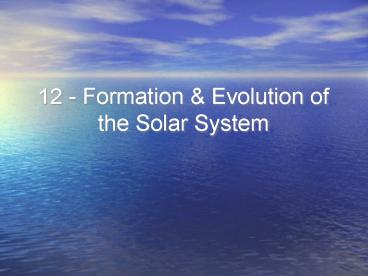12 - Formation - PowerPoint PPT Presentation
1 / 25
Title:
12 - Formation
Description:
4 Terrestrial Planets Mercury Venus Earth Mars 4 Jovian Planets Uranus Neptune Jupiter Saturn (gas giants) (ice giants) Differences in the 2 Main ... – PowerPoint PPT presentation
Number of Views:106
Avg rating:3.0/5.0
Title: 12 - Formation
1
12 - Formation Evolution of the Solar System
2
4 Terrestrial Planets
Mercury
Venus
Earth
Mars
3
4 Jovian Planets
(ice giants)
Uranus Neptune
Jupiter Saturn
(gas giants)
4
Differences in the 2 Main Classes of Planets
- Terrestrial
- Mercury
- Venus
- Earth
- Mars
- Small Diameters
- Small Masses
- Large Densities
- Few Moons
- No Rings
- Rock Metals
Jovian Jupiter Saturn Uranus Neptune Large
Diameters Large Masses Small Densities Many
Moons Rings H, He, (C, N, O)
To Sun
5
Numerous moons, asteroids, comets, Kuiper belt
objects, centaurs, and Pluto (actually a KBO)
Ganymede
Hyperion
Titan
Eros
Kuiper Belt
Hale-Bopp
6
Formation Evolution of the Solar System
Planets, asteroids (minor planets), Kuiper Belt
Objects (another form of minor planet)
- General Structure
7
- Nebular Model
Planets gradually form out of the rotating disk
of gas dust
Beyond the frost line ice can condense,
allowing more massive planets to form
Refractories (rock, metal)
volatiles (ices gas) and refractories
8
- Two possible sequences of formation of
terrestrial (rocky) planets - Merge homogeneous collection of planetesimals,
then differentiate - Form planets while condensation is still happening
9
Do the Big Planets form Differently?
10
Asteroids, also called Minor Planets Same as
planetesimals that formed the terrestrial planets
- Meteorites are pieces of asteroids that have made
it to Earth. Type - Stony
- Iron
- Stony-Iron
- Some stony ones
- contain organics
Ida, with its moon Dactyl
11
Sampling the Early Solar System
12
Kuiper Belt Oort Cloud
13
Kuiper Belt ObjectsTrans-Neptunian Objects
(Eris)
Eris (larger than Pluto)
14
Comets
Comet Hale-Bopp
C/2002 Q2 NEAT
15
forsterite (Mg2SiO4)
16
Comet Dust Silicates CHON Comet Gases H, O,
OH, CN, CH, NH2, C2, C3, CO, CH3OH (methanol),
HCN (hydrogen cyanide), H2O, H2S, CS, H2CO
(formaldehyde), CH3CN, HNC, etc.
Giotto spacecraft image of the nucleus of Comet
Halley (1986)
17
Interplanetary Dust Particles shed by comets
collected in Earths atmosphere - silicates
organics
18
Stardust Spacecraft _at_ Comet Wild 2 in Jan.
2004Returned to Earth with Dust Sample in Jan.
2006
Captured forsterite (Mg2SiO4) grain!
19
Deep Impact - Comet Tempel 1
20
Deep Impact spectral analysis
21
Comet 73P/Schwassmann-Wachmann 3
Fragmented in 1995
Seen again in 2000
22
2006 - Returned In Many Pieces!
Deep Impact-like analysis in preparation - Sitko
et al.
23
Eruption of Comet 17P/Holmes in 2007
Deep Impact-like analysis in preparation - Lisse
et al.
24
(No Transcript)
25
- While many details are not yet known
- basics of the formation of the SS is understood
- chemical/mineral content of early SS becoming
known - no unusual or freak events necessary
- the early SS had organics
- we see the same things around other stars
- We expect planetary systems to be common, and
many may be similar to our own































